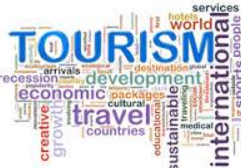COVID-19 Pandemic Causes $2.6 Trillion Loss in Tourism Revenues
COVID-19 Pandemic Causes $2.6 Trillion Loss in Tourism Revenues GKToday


September 21, 2023
The Impact of COVID-19 on Tourism (2020–2022)
The United Nations World Tourism Organization (UNWTO) has released a report titled “International Tourism Highlights, 2023 Edition” that highlights the severe economic impact of the COVID-19 pandemic on the global tourism industry.
How severely was the tourism industry impacted by the COVID-19 pandemic, according to the UNWTO report?
The UNWTO report reveals that the tourism industry lost $2.6 trillion in export revenues due to the COVID-19 pandemic, which was one and a half times more than what it earned in 2019. International tourist arrivals declined by 72% from 1.5 billion in 2019 to 400 million in 2020.
How did the export revenues from international tourism change during the pandemic years?
In 2020, export revenues from international tourism dropped to 62% of pre-pandemic levels, representing a loss of $1.1 trillion. This decline accounted for 44% of the global loss in international trade in that year. Although there was a partial recovery in 2021 and 2022, revenues remained significantly below 2019 levels.
How did the pandemic impact tourism’s contribution to global exports and GDP?
In 2019, revenues from international tourism accounted for 7% of global exports. However, this proportion dropped to 3% in 2020 and 2021 before rebounding to 4% in 2022. The pandemic caused tourism’s contribution to global GDP, measured in tourism direct gross domestic product (TDGDP), to decline from 4% in 2019 to 2% in 2020 and 2021. It then increased to 2.5% in 2022, as per preliminary estimates. In 2020, export revenues plummeted to 62% of pre-pandemic levels, accounting for 44% of the global loss in international trade.
What trends were observed in international tourist arrivals and export revenues in 2021 and 2022?
In 2021, international tourist arrivals increased by 12%, reaching 456 million. Export revenues also rebounded slightly but remained 59% below 2019 levels at $761 billion. In 2022, 963 million tourists traveled internationally, more than double the number in 2021. However, this was still 34% lower than pre-pandemic levels in 2019. Export revenues reached $1.25 trillion, reflecting a 52% increase from 2021 but remained 34% below 2019 levels.
What is the overall economic impact of the COVID-19 pandemic on tourism, as highlighted in the report?
The report states that the pandemic led to a loss of 2.6 billion international tourist arrivals in 2020, 2021, and 2022, nearly double the arrivals recorded in 2019. Additionally, tourism’s economic contribution, measured as tourism direct gross domestic product (TDGDP), was halved from 4% of global GDP in 2019 to 2% in 2020 and 2021. It increased to 2.5% in 2022 according to preliminary estimates. The total loss in TDGDP over the three years amounted to $4.2 trillion.
Related Posts
Month: Current Affairs – September, 2023
Category: Reports & Indexes Current Affairs
SDGs, Targets, and Indicators
-
SDG 8: Decent Work and Economic Growth
- Target 8.9: By 2030, devise and implement policies to promote sustainable tourism that creates jobs and promotes local culture and products.
- Indicator 8.9.1: Tourism direct gross domestic product (TDGDP) as a proportion of total gross domestic product (GDP).
- Indicator 8.9.2: Proportion of jobs in tourism industries out of total jobs in the economy.
-
SDG 12: Responsible Consumption and Production
- Target 12.8: By 2030, ensure that people everywhere have the relevant information and awareness for sustainable development and lifestyles in harmony with nature.
- Indicator 12.8.1: Extent to which (i) global citizenship education and (ii) education for sustainable development (including climate change education) are mainstreamed in (a) national education policies; (b) curricula; (c) teacher education; and (d) student assessment.
-
SDG 17: Partnerships for the Goals
- Target 17.17: Encourage and promote effective public, public-private, and civil society partnerships, building on the experience and resourcing strategies of partnerships.
- Indicator 17.17.1: Amount of United States dollars committed to public-private and civil society partnerships.
Table: SDGs, Targets, and Indicators
| SDGs | Targets | Indicators |
|---|---|---|
| SDG 8: Decent Work and Economic Growth | Target 8.9: By 2030, devise and implement policies to promote sustainable tourism that creates jobs and promotes local culture and products. | Indicator 8.9.1: Tourism direct gross domestic product (TDGDP) as a proportion of total gross domestic product (GDP). |
| Indicator 8.9.2: Proportion of jobs in tourism industries out of total jobs in the economy. | ||
| SDG 12: Responsible Consumption and Production | Target 12.8: By 2030, ensure that people everywhere have the relevant information and awareness for sustainable development and lifestyles in harmony with nature. | Indicator 12.8.1: Extent to which (i) global citizenship education and (ii) education for sustainable development (including climate change education) are mainstreamed in (a) national education policies; (b) curricula; (c) teacher education; and (d) student assessment. |
| SDG 17: Partnerships for the Goals | Target 17.17: Encourage and promote effective public, public-private, and civil society partnerships, building on the experience and resourcing strategies of partnerships. | Indicator 17.17.1: Amount of United States dollars committed to public-private and civil society partnerships. |
Analysis
1. Which SDGs are addressed or connected to the issues highlighted in the article?
The issues highlighted in the article are connected to SDG 8 (Decent Work and Economic Growth), SDG 12 (Responsible Consumption and Production), and SDG 17 (Partnerships for the Goals).
2. What specific targets under those SDGs can be identified based on the article’s content?
Based on the article’s content, the specific targets identified are:
- Target 8.9: By 2030, devise and implement policies to promote sustainable tourism that creates jobs and promotes local culture and products.
- Target 12.8: By 2030, ensure that people everywhere have the relevant information and awareness for sustainable development and lifestyles in harmony with nature.
- Target 17.17: Encourage and promote effective public, public-private, and civil society partnerships, building on the experience and resourcing strategies of partnerships.
3. Are there any indicators mentioned or implied in the article that can be used to measure progress towards the identified targets?
Yes, there are indicators mentioned in the article that can be used to measure progress towards the identified targets:
- Indicator 8.9.1: Tourism direct gross domestic product (TDGDP) as a proportion of total gross domestic product (GDP).
- Indicator 8.9.2: Proportion of jobs in tourism industries out of total jobs in the economy.
- Indicator 12.8.1: Extent to which (i) global citizenship education and (ii) education for sustainable development (including climate change education) are mainstreamed in (a) national education policies; (b) curricula; (c) teacher education; and (d) student assessment.
- Indicator 17.17.1: Amount of United States dollars committed to public-private and civil society partnerships.
These indicators can be used to measure progress towards the targets by tracking the TDGDP as a proportion of total GDP, the proportion of jobs in tourism industries, the extent of global citizenship education and education for sustainable development, and the amount of funding committed to public-private and civil society partnerships.
Behold! This splendid article springs forth from the wellspring of knowledge, shaped by a wondrous proprietary AI technology that delved into a vast ocean of data, illuminating the path towards the Sustainable Development Goals. Remember that all rights are reserved by SDG Investors LLC, empowering us to champion progress together.
Source: gktoday.in

Join us, as fellow seekers of change, on a transformative journey at https://sdgtalks.ai/welcome, where you can become a member and actively contribute to shaping a brighter future.








